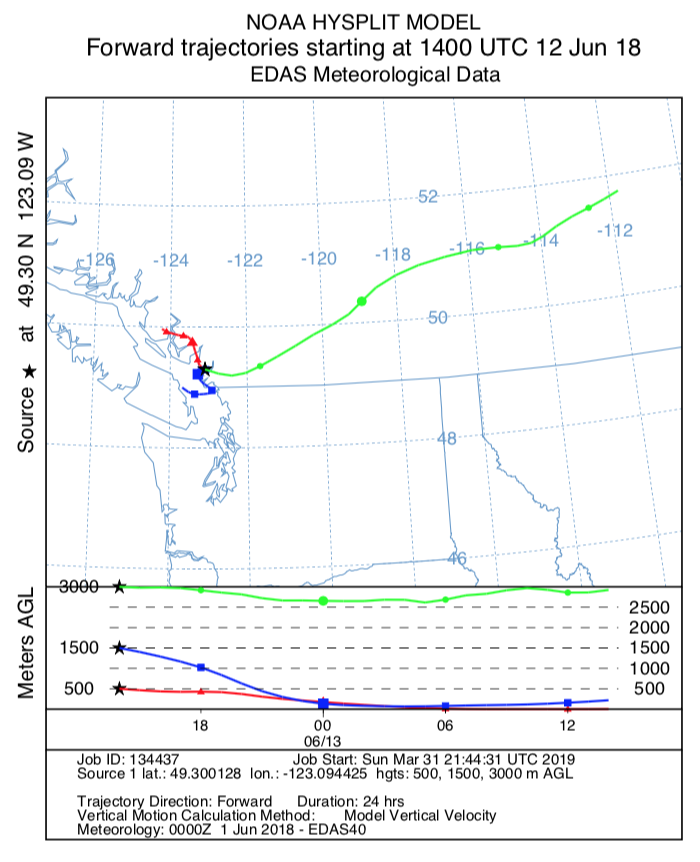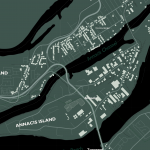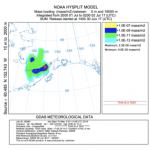Final Project for GEOB 402
Objectives:
- Examine a specific event using a modeling tool (e.g HYSPLIT, Gaussian or Plume Model)
- Use existing data sets to explore an air quality issue
- Examine a specific topical issue
Summary:
In 2016, the Canadian Government granted approval to the expansion of the Trans Mountain Pipeline (also known as the Trans Mountain Expansion Project) 1. The project aims to secure Canada’s oil revenues 1. The expansion is expected to cost around $7.4 billion to built and is a twinning of the existing 1,150 km pipeline between Strathcona County, Alberta and Burnaby, BC. This new pipeline system is expected to increase nominal capacity of the system from 300,000 barrels per day to 890,0001. The extension is expected to start at the Kinder Morgan terminal, through the Burrard inlet (under Lions Gate) and out into the Strait of Georgia 1. This expansion is expected to see a seven-fold increase in oil tanker traffic moving through Burrard Inlet. Currently, ship transport into the Port of Vancouver accounts for 15% of total Canadian ship transport (~ 3000 oil tankers) per year 2. Each individual tanker is estimated to carry up to 850,000 barrels of oil (120,000 dead weight tons) 2. Currently, oil tankers make up 2% of ship movement in the Lower Mainland 2. With the current expansion project – this figure is expected to see a dramatic increase to around 14% of ship traffic from oil tankers 2.
Oil tankers have multiple environmental impacts associated with them – negative impacts to fisheries, local marine wildlife, air and noise pollution. While the frequency of oil spills from tankers have shown an progressive downward trend, a potential spill does pose a threat to Vancouver’s waterways. The shipping industry contributes to air pollution via emissions of CO2, NOx, SOx and PM2.5 via engine fuel burning. It is a very important industry, with 80% of all cargo and goods moved through this mode. Around 1.6% of total Canadian CO2 emissions come from shipping 2.
This poster aimed to look at a worst-case scenario where the largest possible oil tanker entering the Burrard Inlet was to experience a massive explosion with fuel and cargo was burned and released as into the atmosphere as CO2. Assuming that a single tanker carries 850,000 barrels, around 114,750,000 kg of oil is moved in a single tanker. Accounting for the burning of each kg – ~ 361,462,500 kg of CO2 will be produced if all the cargo on the ship was to burn in an explosion. This single event would account for 0.05% of Canada’s annual CO2 emissions.
The Hybrid Single Particle Lagrangian Integrated Trajectory Model (HYSPLIT) is a computer model that is used to compute air parcel trajectories, deposition and dispersion of atmospheric pollutants.

Fig 1: HYSPLIT Trajectory from a potential oil tanker explosion in the Burrard Inlet
Modelled concentrations shows levels of pollutants over 1000 mg/m3 with the pollutant remaining over Metro Vancouver over the 24-hour period. Concentrations exceeded the set Canada Wide Standards (CWS) for PM2.5 (30 µg/m3, 24-hour averaging time). Synoptic maps for June the 12th a stationary front over Vancouver, this could explain the slow dispersion as stationary fronts are associated with light winds and no mass transfer as the two air masses are not strong enough to replace each other. Seasonal and diurnal patterns play a role – 2:00PM, in June is the hottest time of day in the hottest month. This gives possibly for smaller temperature gradients and atmospheric stability. The trajectory model (Fig. 1) shows release heights of 500, 1500 and 3000 meters AGL. Both the 500, 1500 meters stick around the coast, while the 3000 meters ends up closer to the Okanagan. Due to the close proximity to Metro Vancouver, an oil tanker spill could have noticeable effects of air quality and visibility. While, it is quite rare for all the oil to burn within a span of hours (the scenario doesn’t account for extinguishing the fire), the results show than even if 5-10% of oil was to be burned it would still have notable impacts to the lower mainland’s air quality.
Find the Whole Poster: Explosion Scenario Vancouver Harbour




